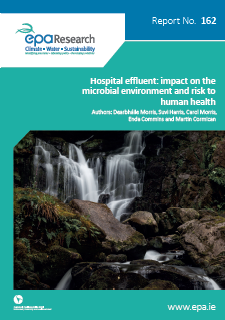Research 162 - Hospital effluent: impact on the microbial environment and risk to human health
Authors: Dearbháile Morris, Suvi Harris, Carol Morris,Enda Commins and Martin Cormican
Summary: Antibiotic resistance is a major public health problem. In Ireland, and most of Europe, hospital effluent is released into the urban wastewater system without any specific measurement of antibiotic levels or antibiotic-resistant bacteria, and without any pre-treatment.

Antibiotic resistance is a major public health problem. In Ireland, and most of Europe, hospital effluentis released into the urban wastewater system without any specific measurement of antibiotic levels orantibiotic-resistant bacteria, and without any pre-treatment.There are concerns that the release of these contaminantsinto the urban wastewater may result in downstreamexposure to antibiotics and contribute to the growingproblem of antibiotic resistance. In this report, a threeyear study was undertaken to 1) quantify the impact ofhospital discharge on the number of antibiotic resistant E.coli and concentration of antibiotics in urban waste water,2) estimate the survival of antibiotic resistant E. coli in eachstep of the waste water treatment process to discharge,3) estimate the persistence/removal of antibiotics in eachstep of the waste water treatment process to discharge,4) develop a risk assessment model of human exposureto antibiotics and antibiotic resistant E. coli in recreationalwater related to discharge in hospital effluent.
Identifying Pressures
This report demonstrates that there are high levels ofantibiotic-resistant E. coli in urban wastewater, and dealingwith hospital effluent in isolation will not substantiallyaddress the overall issue of antibiotic-resistant bacteriain urban wastewater. The report identifies that, at best,wastewater treatment plants (WWTPs) do not removeor inactivate all antibiotic-resistant bacteria and thatfurther research is required to understand the processesunderlying this and identify risk management strategies.This research also reveals that some antibiotics maypersist in the environment for extended periods afterdischarge and that the predicted levels of antibiotics in theenvironment are such that they may plausibly contributeto the development and maintenance of antibioticresistance.
Informing Policy
The research informs current policies on protection ofpublic health from water borne contaminants and thenecessity for development of additional indicators ormonitoring strategies. The research builds capacity in thearea of Environment and Health. The research is relevantin the context of the EU Water Framework Directive, theEuropean Commission’s ‘A Blueprint to Safeguard Europe’sWater Resources’ and to the 7th EU Environment ActionProgramme which aims “to safeguard the Union’s citizensfrom environment-related pressures and risks to healthand wellbeing”. The research also informs the followingnational regulations and EU directives, the EU WaterFramework Directive, the Urban Wastewater Directive(1991); the Bathing Water Directive (2008); and theDrinking Water Directive (2014).
Developing Solutions
The research identifies that new antibiotics, such asthe quinolones/fluoroquinolones, have the lowest rateof degradation and the highest resistance formationpotential and provides a method which could be used tocreate a mechanistic model that can assess antimicrobialresistance formation potential. This study providesvaluable evidence that high levels of antibiotic resistantE. coli are present in urban wastewater, and highlightsthe need for the development of international guidelinesregarding regulation, monitoring and reporting ofantibiotics and antibiotic resistant bacteria in the urbanwastewater and receiving environments.
https://www.epa.ie/media/epa-2020/publications/research/Thumb162[1].png